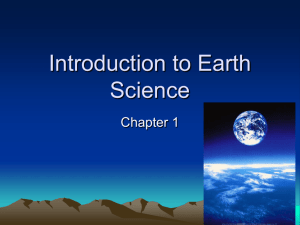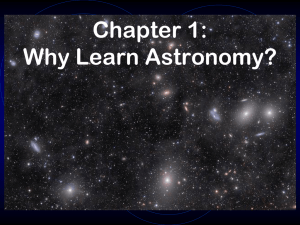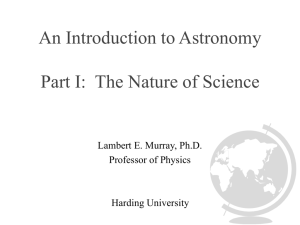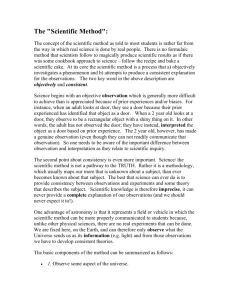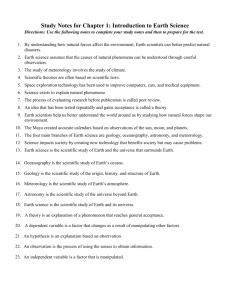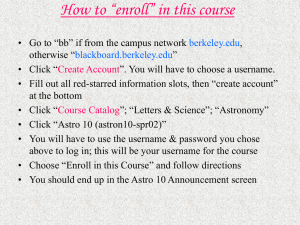UK_Astronomy_in_Schools_Liverpool
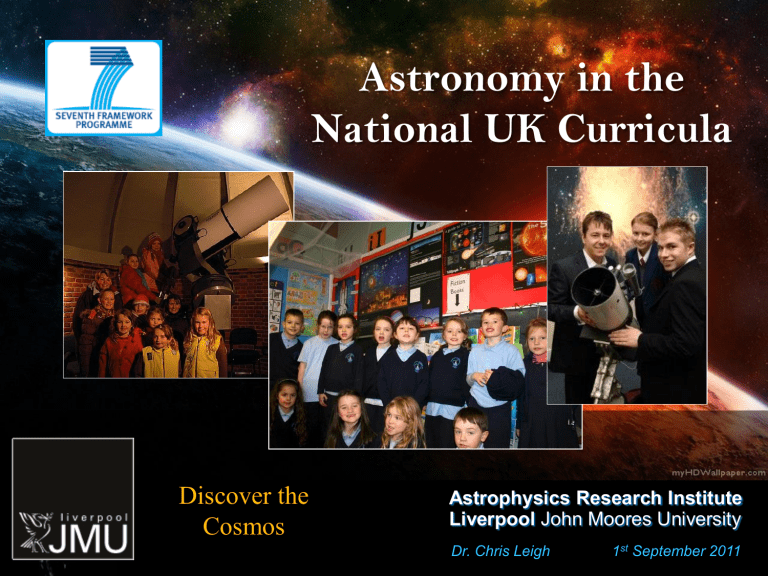
Astronomy in the
National UK Curricula
Discover the
Cosmos
Astrophysics Research Institute
Liverpool John Moores University
Dr. Chris Leigh 1 st September 2011
Astronomy in the UK
Astronomy in Scottish Schools
Astronomy in Primary Schools – England and Wales
Key Stage 2 : Age 8-11
Topic: SC4
Physical Processes
Section: 4
The Earth and beyond
Pupils should be taught:
The Sun, Earth and Moon
• that the Sun, Earth and Moon are approximately spherical.
Periodic changes
• how the position of the Sun appears to change during the day, and how shadows change as this happens.
• how day and night are related to the spin of the Earth on its own axis.
• that the Earth orbits the Sun once each year, and that the Moon takes approximately 28 days to orbit the Earth.
Astronomy in Secondary Schools – England and Wales
Key Stage 3 : Age 11-14
Topic: SC4
Physical Processes
Section: 4
The Earth and beyond
Pupils should be taught:
The Solar System
• how the movement of the Earth causes the apparent daily and annual movement of the
Sun and other stars.
• the relative positions of the Earth, Sun and planets in the solar system.
• about the movements of planets around the Sun and to relate these to gravitational forces
• that the Sun and other stars are light sources and that the planets and other bodies are seen by reflected light.
• about the use of artificial satellites and probes to observe the Earth and to explore the solar system.
Astronomy in Secondary Schools – England and Wales
Key Stage 4 : Age 14-16
Topic:
How Science Works
Section: 8
Environment, Earth and
Universe
Pupils should be taught:
The Solar System
• the solar system is part of the universe, which has changed since its origin and continues to show long-term changes.
*********
Note that the KS4 is vague because, at this age, students study for their first major examinations
(GCSEs) and the content of lessons is driven by the examination boards.
GCSEs – Edexcel
2011 Specifications
GCSE in Astronomy
Earth, Sun and Moon; Planetary Systems; Stars; Galaxies and Cosmology
Coursework (75%), Controlled Assessment (25%)
GCSE in Physics
Unit P1: Universal physics
Visible light and the Solar System; Electromagnetic Spectrum; Waves and the Universe
Coursework (75%), Controlled Assessment (25%)
GCSE in Science
Unit P1: Universal physics
Visible light and the Solar System; Electromagnetic Spectrum; Waves and the Universe
Coursework (75%), Controlled Assessment (25%)
GCSEs – OCR
2011 Specifications
GCSE in Science A
Module P1: The Earth in the Universe
What do we know about the place of the Earth in the Universe
Coursework (75%), Controlled Assessment (25%)
GCSE in Physics A
Module P1: The Earth in the Universe (as per Science A)
Module P7: Further Physics – Studying the Universe
Naked eye astronomy; Light, telescopes and image; Mapping the Universe; The Sun, the stars and their surrounding; The astronomy community
Coursework (75%), Controlled Assessment (25%)
A level (GCE) / EPQ – OCR, AQA, WJEC and Edexcel
Key Stage 5 (Sixth Form) Age 16-18
OCR: A level in Physics A
Module 5: Modelling the Universe
Gravitational Fields; Structure of the universe; The evolution of the universe
AQA: A level in Physics A
Unit 5 : Section B : Astrophysics Option
Lenses and Optical Telescopes; Non-optical Telescopes; Classification of Stars; Cosmology
WJEC: A level in Physics
Unit PH2: Waves and Particles
Matter, Forces and the Universe; Photons; Using radiation to investigate stars edexcel: A level in Physics
Unit 5: Physics from Creation to Collapse
Astrophysics and Cosmology, incl. Life Cycle of Star, Energy Sources in Stars
Any Questions ?
Dr Chris Leigh
Astrophysics Research Institute
Liverpool John Moores University cjl@astro.livjm.ac.uk

